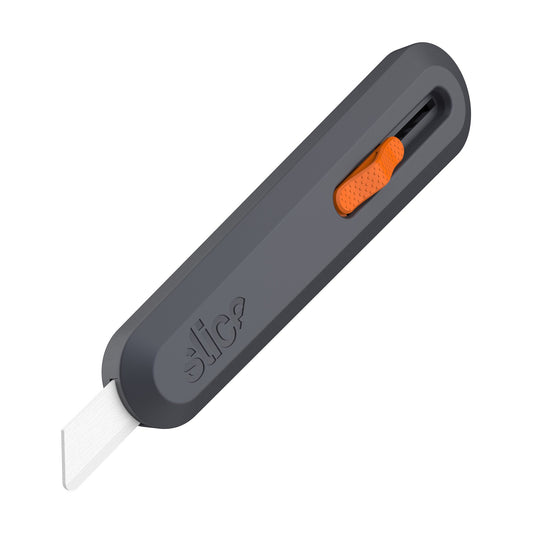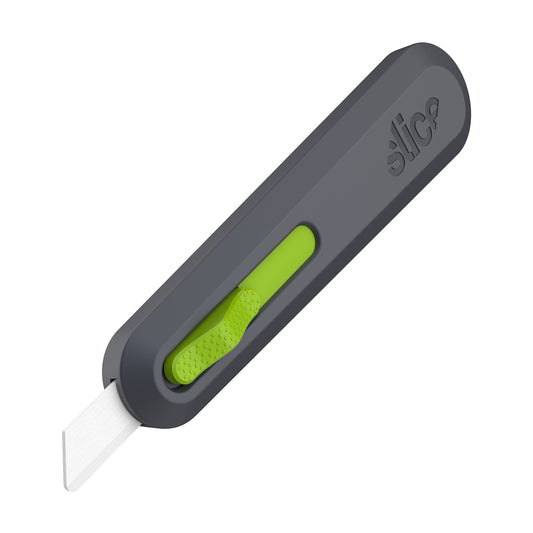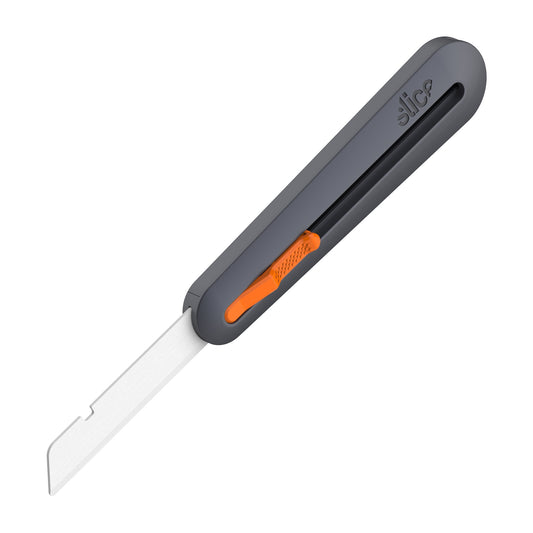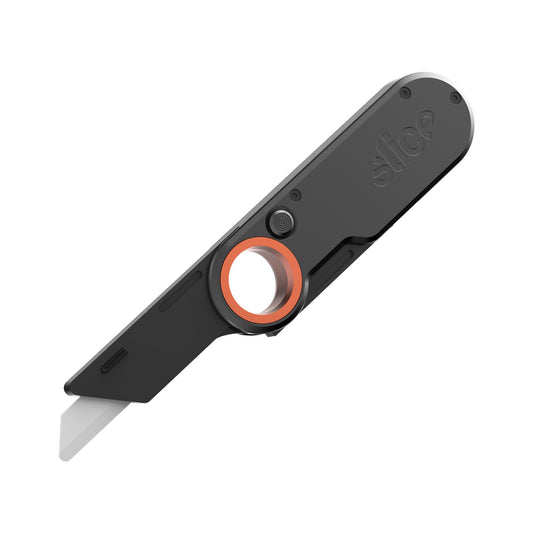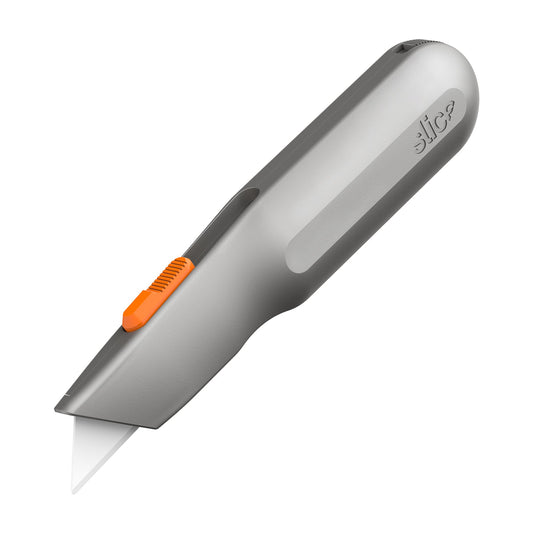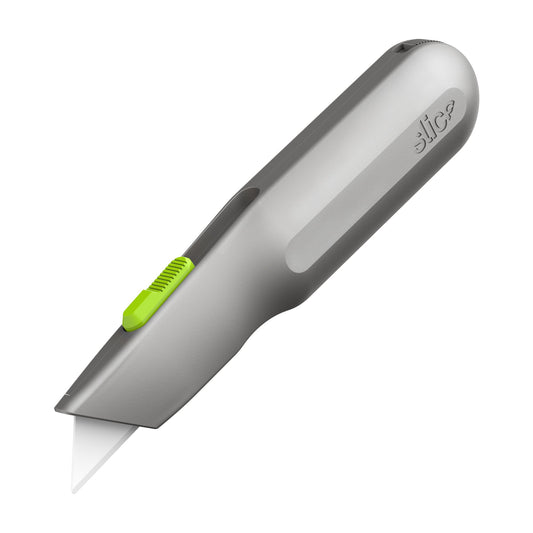How to Cut Drywall Safely With Slice
This video shows how to cut drywall safely with the Slice Folding Utility Knife, using the optional 10528 pointed-tip blade.
Slice also makes three retractable-blade utility knife models: the Manual Utility Knife, the Auto-Retractable Utility Knife, and the Smart-Retracting Utility Knife. All of these tools ship with the 10526 rounded-tip utility blade and are compatible with the 10528 pointed-tip utility blade.
Slice blades are made of 100 percent zirconium oxide, a high-quality advanced ceramic. Our patent-pending blade design is finger-friendly®: it’s safe to the touch. Slice rounded-tip blades are so safe, they don’t require a sharps container for disposal.
There is no shortage of tutorials about how to cut drywall, but rarely do they talk about staying safe. Learn how to safely make standard straight cuts on drywall.
While we won’t cover how to cut drywall on the wall or how to cut drywall hole pieces, many of the same safety tips apply because all these tasks require you to use a cutting tool.
Whenever you use a cutting tool, be it a drywall cutter or a box cutter, safety should be your first consideration. Lacerations are far too common but they are largely preventable if you take the appropriate precautions. If you’re mindful of every part of your drywall-cutting process, you’ll finish injury free with a job well done.
First Safety—Then Measure Twice, Cut Once
“Measure twice, cut once” is a familiar guideline whenever you’re cutting materials. By taking the time to be certain you’re cutting your materials to the right size, you save time and money. But there’s something much more important to look after before concerning yourself with materials, and that’s you. If your cutting job results in a laceration because you didn’t follow safe cutting protocols, you’ll be out much more time and have concerns more pressing than wasted materials.
At the least, a laceration hurts and disrupts your project. Serious cuts may require a trip to the ER, stitches, or even surgery. This is costly, painful, and time consuming. Hands and fingers suffer the bulk of lacerations caused by hand tools. And healthy hands are necessary for just about everything you do, especially construction or home repair projects.
Further, hands are complex structures that are difficult to heal. A laceration will slow or temporarily stop your ability to carry out construction or repair work. If it’s bad enough, a laceration can cause permanent damage. Eliminating health and safety risks should always be the first order of business. So before you get to the “how to” of any project, address your safety protocols.
The Right Drywall Cutting Tools Are the Safest Cutting Tools
In order to cut drywall, you’re going to need the appropriate drywall cutter. There are several options when it come to drywall cutting tools, so you have choices. Working from the “safety first” framework, the best tool to cut drywall is always the safest option.
Blade Exposure
The traditional approach to making cutting tools safer is to reduce blade exposure. This has led to two common tool designs: a handle that folds and a handle that allows blade retraction. Both allow you to safely store the blade in the tool when it’s not in use.
A Safer Blade?
The only issue with this approach is that it doesn’t address the primary hazard: the blade. It’s not the handle that cuts you after all; it’s the blade.
Metal and traditional ceramic blades are overly sharp. This is a remnant of metal blade design because metal is relatively soft and dulls quickly. Blades are most dangerous when they are too sharp and when they’re dull.
Slice® is the only manufacturer to make a safer blade. All Slice blades are made of 100 percent zirconium oxide, a high-quality advanced ceramic. Our patent-pending blade design is finger-friendly®: it’s safe to touch. Slice rounded-tip blades are so safe, they don’t require a sharps container for disposal.
Slice blades have also been third-party tested to last up to 11 times longer than steel. This means fewer blade changes, and common-sense safety dictates that you should handle any blade as infrequently as possible. Slice blades also feature these properties:
- Never rust
- Non-magnetic
- Non-corrosive
- Maintenance free
Ergonomics
Ergonomics is a key feature of tool safety. Drywall cutting tools that are ergonomically designed fit well in your hand and make the cutting motion feel natural. A well designed tool should feel like an extension of your body and not cause any awkward, strained, or uncomfortable movements. This helps reduce fatigue, a common cause of injuries.
Slice Covers All the Safety Bases
Slice tools feature our proprietary safety blades and are ergonomically designed. When looking for the best tool to cut drywall among the Slice lineup of tools, the Folding Utility Knife is an excellent choice, as are our three retractable-blade utility knife models: the 10550 Manual Utility Knife, 10554 Auto-Retractable Utility Knife, and 10558 Smart-Retracting Utility Knife. All four designs are ambidextrous. Lefties rejoice!
All of these tools ship with the 10526 rounded-tip utility blade and are compatible with the 10528 pointed-tip utility blade. The model and blade you choose depends on how you’ll use the tool and the level of safety you require.
How to Cut Drywall
Now that you’ve got your safety in hand, it’s time to cut some drywall. Place your drywall piece on a stable surface, face-up, and measure—twice—to where you want to make your cut. Then use a pencil to mark the line your cutting tool will follow.
To cut drywall, you only need to score it. If you’re concerned about how to cut drywall straight, it’s best to use a straightedge to guide your cutting tool. Once you’ve scored your drywall, align the scored line just over the edge of your cutting surface and give the bit hanging over the edge a gentle but firm tap. The drywall will easily break at your line.
Here’s an alternate method to break your drywall: after you’ve scored it, hold the piece perpendicular to the floor with one hand on either edge and the score mark positioned horizontally and facing away from you. Line up your knee with the score mark from behind and give a gentle but firm push.
You’ll see now that your desired piece of drywall isn’t completely free; it’s connected by a backing. To finish the job, use your retractable utility or folding knife and cut through that final layer of material. That’s it!
Drywall can be used for many home renovations and repairs. Whether you’re looking for how to cut drywall on ceiling surfaces or the best way to cut drywall holes, start first with safety.
Now that you know how to cut drywall safely in standard straight cuts, how will you apply your new skills?

